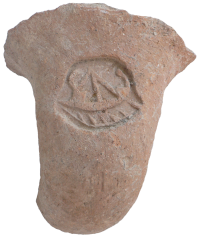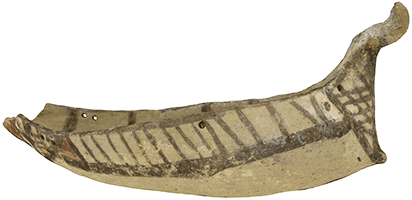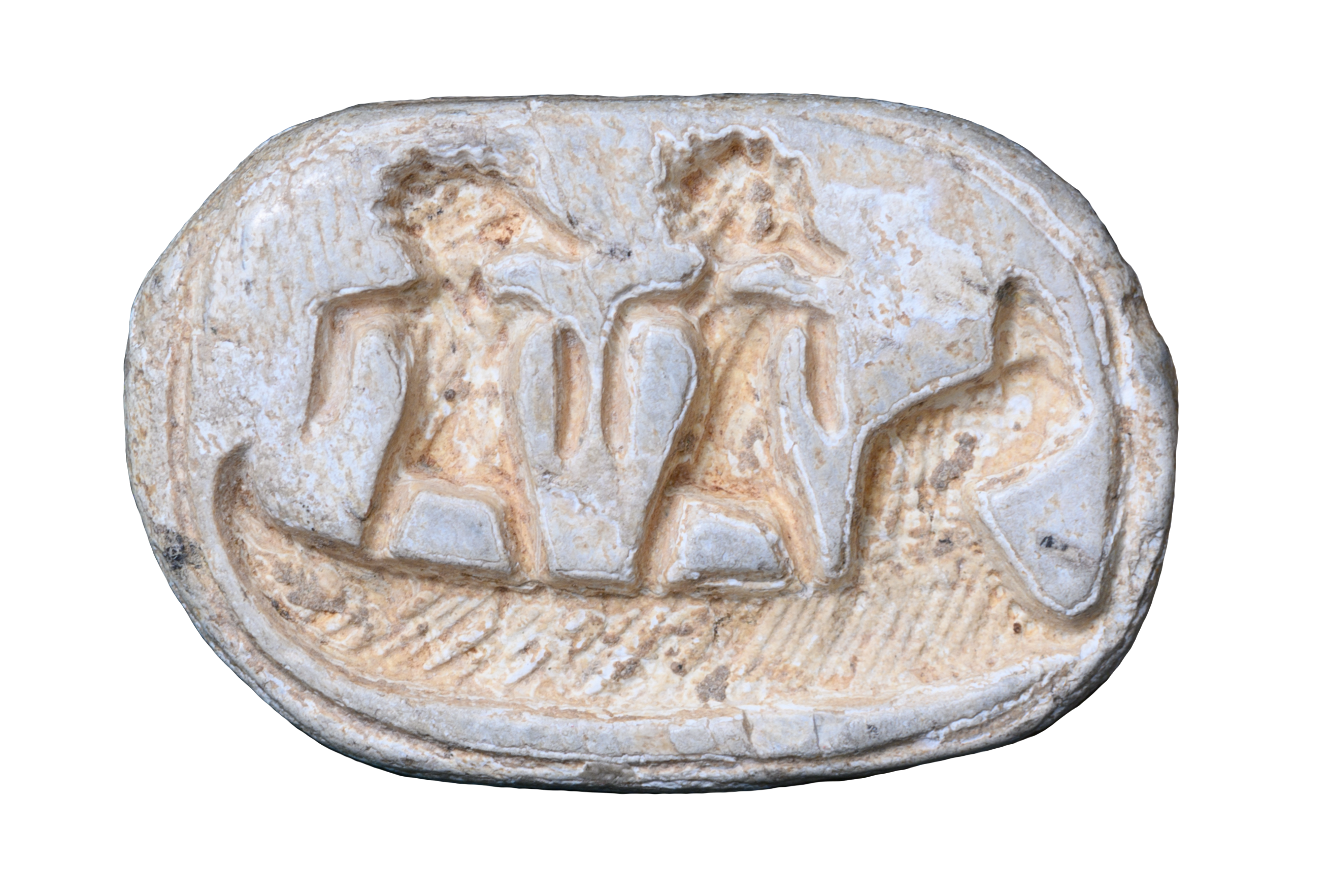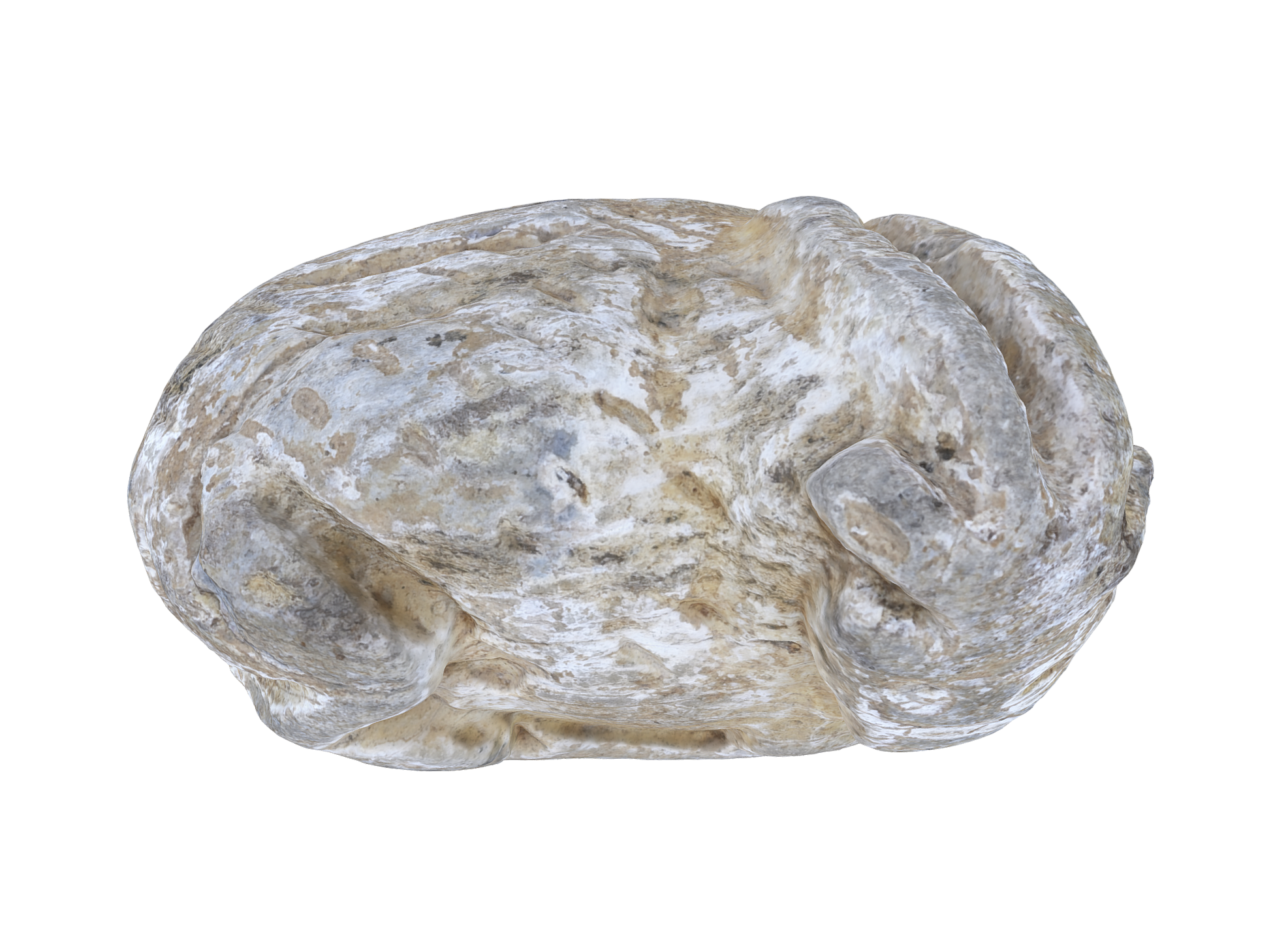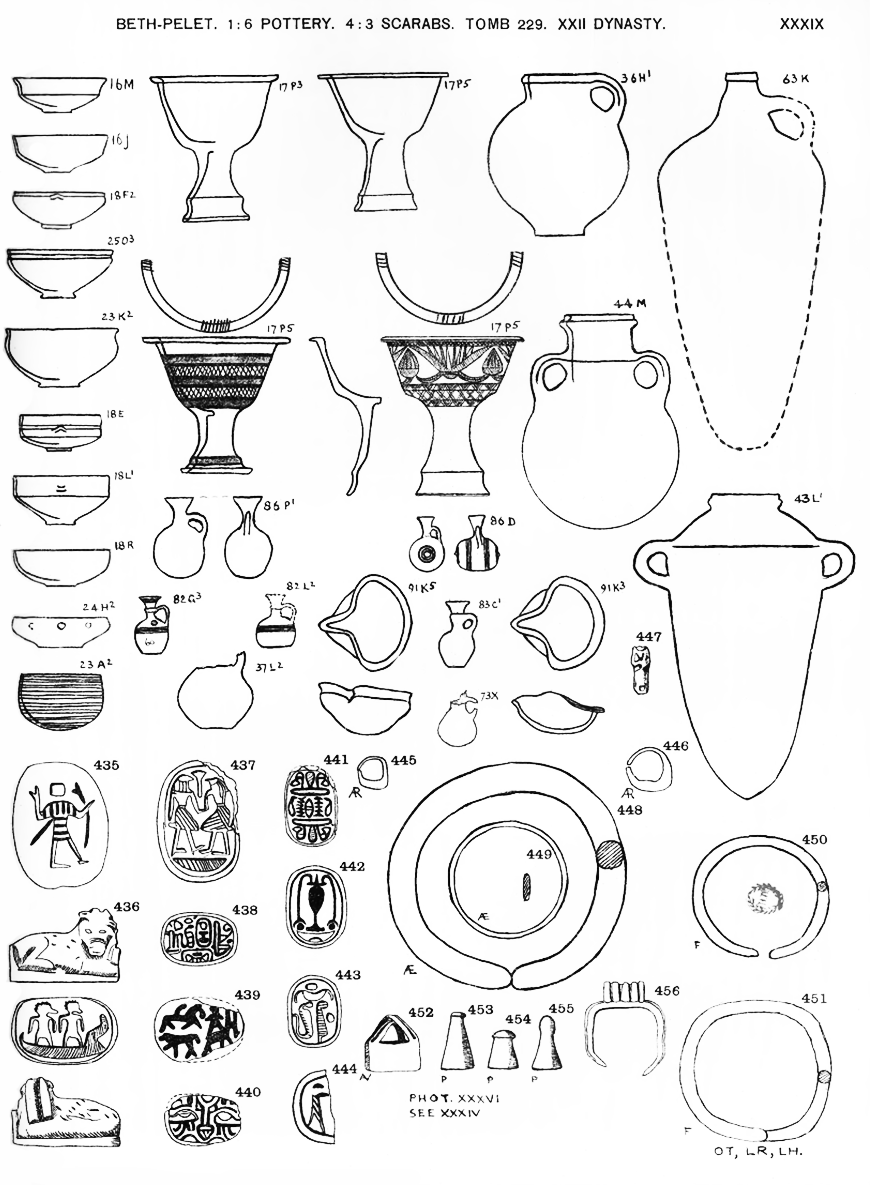Galley with a flat hull facing right. The bow is massive, with a backward slanting stempost integrating a short triangular shaped ram. The stempost ends in a thick horn device that inclines forward then sharply curves upwards. The sternpost curves gently and is much shorter, ending in a simple tail-like terminal. The entire ship is decorated with simple hatching - oblique strokes for the hull and vertical for the stempost device. The mast and rigging are absent to accommodate two bearded male figures clad in short tunics facing towards the bow, their arms hanging along their body.
zoomorphic scaraboid
L59
Iron IIA (10th-9th centuries B.C.)
tomb 229, cemetery 200, Tell el-Far'ah (South)
L: 2.03 cm; W: 1.33 cm; thickness: 1.25 cm; diameter hole: 0.2 cm
Scaraboid in the shape of a couchant antelope, with long horns trailing down its back. Pierced lengthwise.
London Institute of Archaeology EVII.59/36
Keel 2010: 162-163, no. 311; 1995: 67, fig. 91; Petrie 1930: pl. 39, no. 436; Stoof 1992: 64, 202, 205, 207, 340 no. 422
Tell el-Far’ah (South) is located 24 km southeast of Gaza. Established on a loess cliff above the banks of the the Nahal Besor (Wadi Ghazze), it is the last tell site on the road from the Mediterranean southwards into the Negev desert. The ancient name of the site remains a matter of debate. First excavated by Petrie in 1928, his work uncovered hundreds of graves dating from the Middle Bronze Age through the Persian period. Cemetery 200 is the northernmost cemetery of the seven major cemeteries excavated at Tell el-Far’ah South, with a total of 65 burials (37 inhumations, 28 cremations) dating to the Iron Age IIA and IIB. The cemetery stands out for being the only one with a significant number of graves of the late Iron Age IIA period, equated to the 9th century B.C. (Lehmann et al 2019). With the exception of the child burials, all of the inhumations were stone-lined cist graves covered with large slabs of local limestone orientated west-east (Tufnell 1930: 11). It appears that the graves were either marked or their location was well known, given the minimal number of cases of later graves cutting into earlier ones. The cist burials had repeated use, with all genders and age groups represented. Most contained less than 20 burials but a few containing far more, with as many as 116 adults and six children recorded from grave 201. (Lehmann et al 2019: 21).
Cemetery 200 is characterized by continuity and expansion during Iron Age IIA. Among the 37 cist grave inhumations, 23 (62%) were first buried in the early Iron Age IIA (10th century B.C.), with most (57%) of them remaining continuously in use in the late Iron Age II. Although graves dating to the early Iron Age IIA have been found at other cemeteries of the site, cemetery 200 is notable for being the only one to show continuity from the early to the late Iron Age IIA. Late Iron Age IIA saw the introduction of a new burial custom in the form of 28 cremations, with the cemetery being abandoned early in Iron Age IIB. It appears that after more than 150 years of continuous use during the earliest stages of the Iron Age, the site’s other cemeteries were all abandoned while cemetery 200 was founded.
Grave 229 is one of only two inhumation graves that stand out for having both many burials and numerous grave goods. Despite their fragmentary nature, the finds from the tomb are impressive, including several pottery shapes (of which some are Cypriot imports), bronze vessels, iron weapons, jewelry of gold, silver, bronze and iron, numerous scarabs, various faience objects and worked bone:
| pottery | 14 bowls (4 red slipped, 3 pedestalled), 8 juglets (some Cypriote), 2 jars, 2 jugs, 2 saucer lamps |
| bronze | Strainer, bowl, jug handle, bracelet, ring, bowl or strainer fragments, 2 bracelet fragments, earring or finger ring fragments, rivets, nail, 6 bronze fragments |
| iron | 2 dagger fragments, knife fragments, 13 arrowheads + fragments from at least 8 more, 2 bracelets + more fragments, 7 iron bracelet, fitting and handle fragments |
| gold | crescent pendant, ring, basket pendant |
| silver | 2 drop-lunate earrings |
| stone | carnelian, hematite and shell necklace, 4 steatite scarabs, hematite disc fragment, hematite pebble, stone balance weight |
| faience | 3 scarabs, scaraboid, 2 amulets, 3 gaming pieces, bead necklace, glass bead fragments |
| bone | worked bone (possibly inlays for a cosmetic container), bone scarab, shell fragments |
Table 1. tomb 229 grave goods
The bow morphology of this galley is rather advanced. In spite of the fact that the bow projection appears small, it is fully integrated to the stempost which suggests the necessary reinforcement for ramming. The horn is exaggeratedly large. It is possible however that some of its thickness is due to the fact that it includes the forecastle, which the artist might have merged for the sake of simplification. He has done this, at the very least for the mast and rigging, to give room for the two figures. This type of horn on galleys is attested from both Cyprus and the Levant, but appears in the Levant much earlier and is thus probably of Phoenician origin.
Keel, O. 1995. Corpus der Stempelsiegel-Amulette aus Palästina/Israel (Orbis Biblicus et Orientalis, Series Archaeologica 10). Fribourg and Göttingen.
―――. 2010. Corpus der Stempelsiegel-Amulette aus Palästina/Israel: Von den Anfängen bis zur Perserzeit: Katalog Band II: Von Bahan bis Tel Eton. Fribourg / Göttingen: Academic Press / Vandenhoeck Ruprecht.
Lehmann, G., R. Golding-Meir, R.T. Sparks, and B.-A. Neumeier. 2019. “Tell el-Far’ah (South) Cemetery 200 Revisited.” In D. Varga, Y. Abadi-Reiss, G. Lehmann, and D. Vainstub (eds.) Worship and Burial in the Shfela and Negev Regions Throughout the Ages: Proceedings of the 15th Annual Southern Conference. Beersheba: Israel Antiquities Authority and Ben-Guiron University, pp. 17-30.
Petrie, W.M.F. 1930. Beth Pelet I (Tell Fara). Publications of the Egyptian Research Account and British School of Archaeology in Egypt 56. London: Quaritch.
Stoof, M. 1992. Untersuchungen zu ägyptischen Siegelamuletten in menschlicher und tierischer Gestalt. Eine archäologische und motivgeschichtliche Studie. Frankfurt a.M. (u.a.). Europäische Hochschulschriften. Reihe XXXVIII. Archäologie Bd. 41.
Tufnell O. Burials in Cemeteries 100 and 200. In W.M.F. Petrie (ed.) Beth-Pelet I. London: Quaritch, pp. 11-13.


